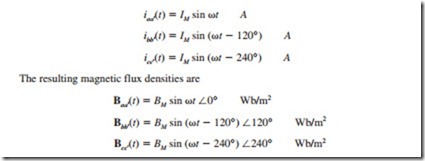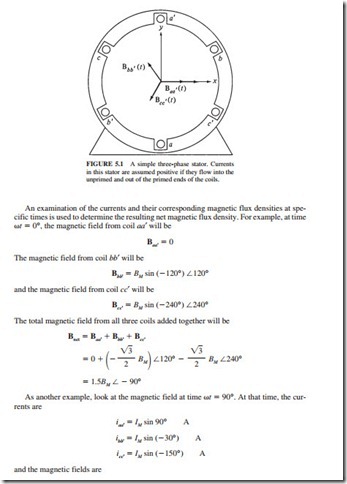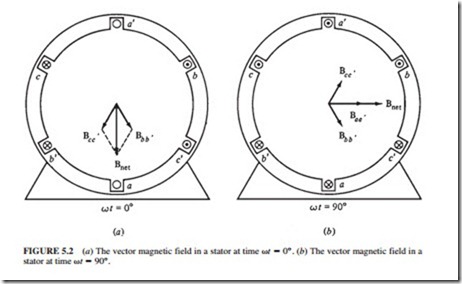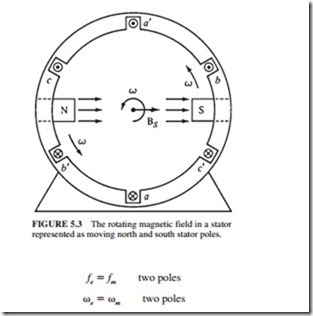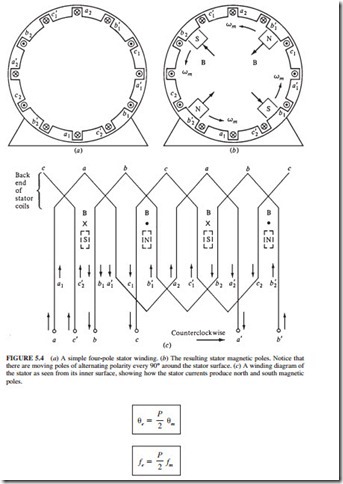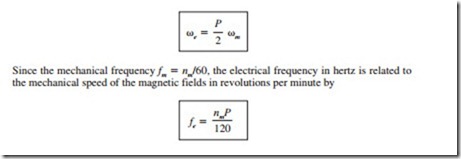AC machines are motors that convert ac electric energy to mechanical energy and genera- tors that convert mechanical energy to ac electric energy. The two major classes of ac machines are synchronous and induction machines. The field current of synchronous machines (motors and generators) is supplied by a separate dc power source while the field current of induction machines is supplied by magnetic induction (transformer action) into the field windings.
AC machines differ from dc machines by having their armature windings almost always located on the stator while their field windings are located on the rotor. A set of three-phase ac voltages is induced into the stator armature windings of an ac machine by the rotating magnetic field from the rotor field windings (generator action). Conversely, a set of three- phase currents flowing in the stator armature windings produces a rotating magnetic field within the stator. This magnetic field interacts with the rotor magnetic field to produce the torque in the machine (motor action).
THE ROTATING MAGNETIC FIELD
The main principle of ac machine operation is this: A three-phase set of currents, flowing in an armature windings, each of equal magnitude and differing in phase by 120°, produces a rotating magnetic field of constant magnitude.
The stator shown in Fig. 5.1 has three coils, each 120° apart.
The currents flowing in the stator are given by
The directions of these fluxes are given by the right-hand rule. When the fingers of the right hand curl in the direction of the current in a coil, the thumb points in the direction of the resulting magnetic flux density.
The resulting magnetic flux is shown in Fig. 5.2. Notice that the direction of the magnetic flux has changed, but its magnitude remained constant. The magnetic flux is rotating counterclockwise while its magnitude remained constant.
Proof of the Rotating Magnetic Flux Concept
At any time t, the magnetic flux has the same magnitude 1.5BM. It continues to rotate at angular velocity w. A proof of this concept is presented in Ref. 1.
The Relationship between Electrical Frequency and the Speed of Magnetic Field Rotation Figure 5.3 illustrates that the rotating magnetic field in the stator can be represented as a north and a south pole. The flux leaves the stator at the north pole and enters the stator at the south pole. The magnetic poles complete one complete revolution around the stator sur- face for each electrical cycle of the applied current. Therefore, the mechanical angular speed of rotation in revolutions per second is equal to the electrical frequency in hertz:
where fm and wm are the mechanical speed of rotation in revolutions per second and radians per second, respectively. Both fe and we are the electrical frequency (speed) in hertz and radians per second, respectively.
The windings on the two-pole stator shown in Fig. 5.1 occur in the order (taken counterclockwise)
Figure 5.4 illustrates the two north poles and two south poles that are produced in the stator when a three-phase set of currents is applied to the stator.
In this stator, the pole moves around half the stator surface in one electrical cycle. Since the mechanical motion is 180° for a complete electrical cycle (360°), the electrical angle 8e is related to the mechanical angle 8m by
Reversing the Direction of the Magnetic Field Rotation
The direction of the magnetic field’s rotation is reversed when the current in any two of three coils is swapped. Therefore, it is possible to reverse the direction of rotation of an ac motor by just switching any two of the three phases (Ref. 1).
